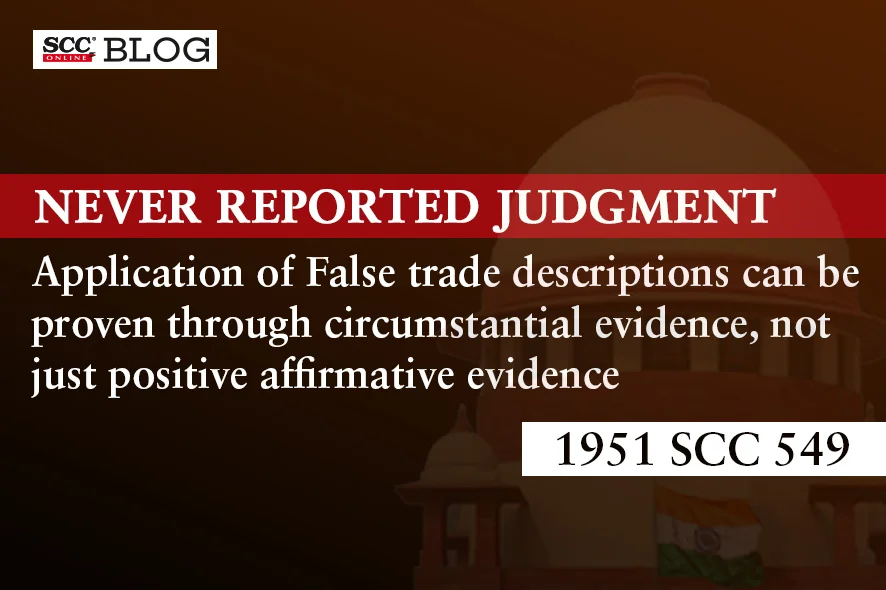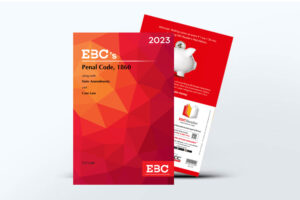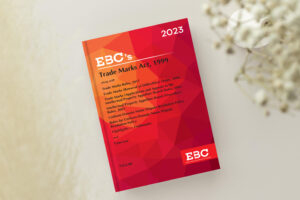Supreme Court: In a case wherein an appeal was filed from a judgment and order of the Bombay High Court, convicting the appellants under Section 6 of the Merchandise Marks Act, 1889 (‘Act’) and Section 486 of the Penal Code, 1860 (‘IPC’) in respect of a toilet preparation described as “Anne French, cleansing milk” with a label affixed thereon, the 3-Judges Bench of Harilal Kania, C.J.,* and M.C. Mahajan and Chandrasekhara Aiyar, JJ., held on facts, that the description “Anne French Cleansing Milk 4, Old Bond St. London W1”, indirectly meant a description as to the place and country in which the goods were made or produced. Thus, it was falsely conveyed that the toilet preparation contained in bottles was made in London whereas in fact it was manufactured in India. This Court, thus, affirmed the decision of the Bombay High Court of convicting Appellant 1 under Section 6 of the Act. This Court further held that the application of false trade description to goods by Appellant 1, need not necessarily be proved by positive affirmative evidence and could be proved by circumstantial evidence also.
Background
Appellant 1 was a private limited company and Appellants 2 and 3 were its directors. On 7-6-1949, Dr. Dhume, Deputy Director of Industries, Department of Industries, Bombay, filed a complaint against these three appellants and two other Directors of Appellant 1 alleging that amongst the articles manufactured in Bombay by the appellants, there was a facial cream called “Anne French Cleansing Milk” which was sold by the appellants in bottles with a label on which was printed “Anne French Cleansing Milk 4, Old Bond St. London W1”. The label nowhere stated that the preparation contained in the bottle was produced in India. It was contended that on the contrary the whole get-up and descriptive words on the label were fraudulently intended and calculated to suggest that the bottle contained a preparation manufactured in England.
The appellants were selling the said preparation with the above-described label through various stores, inter alia, in Bombay. One of the bottles sold by a retail dealer was purchased by Dr. Dhume on 30-5-1949, with the said label and description. Therefore, Dr. Dhume charged the appellants with applying false trade description to the goods. The Magistrate framed the charge and after considering the evidence, acquitted all three appellants.The State of Bombay filed an appeal, and the Bombay High Court reversed the acquittal and convicted the three appellants under Sections 6 and 7 of the Act and under Sections 482, 486 and 487 of the IPC. The appellants filed an appeal before this Court. The Bombay High Court passed the sentence of one month’s rigorous imprisonment on Appellants 2 and 3 and a fine of Rs 200 under Section 6 of the Act and a sentence of three months’ rigorous imprisonment and a fine of Rs 1000 under Section 486 of the IPC. As regards Appellant 1, a fine of Rs 200 under Section 6 of the Act and Rs 1000 under Section 486 of the IPC was imposed. Therefore, the appellants filed an appeal before this Court.
Analysis, Law, and Decision
This Court in respect of the directors of Appellant 1, opined that there was no evidence on record to prove their guilty intention and hence, this Court quashed their conviction and had set aside their sentences. This Court further noted that it was not disputed that Appellant 1 hadmanufactured in India the “cleansing milk” and had sold the same in bottles with the label in question. The Court observed that to sustain a conviction under Section 6 of the Act it was necessary to prove that there was a “false trade description”. The expression “trade description” was defined in Section 2(2)(b) of the Act, the relevant part of which was:
“2. (2) ‘trade description’ means any description, statement, or other indication, direct or indirect’-
(b) as to the place or country in which, or the time at which any goods were made or produced….”
This Court stated that when evidence was given before the Magistrate, no alternate suggestion was put forth on behalf of the appellant and it was not suggested that any other construction was proper or even plausible. This Court further stated that the contention that the address might be a part of the trade mark of the producer or a dealer depends on the facts proved in each case and moreover, in the absence of any evidence on record, the Court opined that it was unable to take into consideration hypothetical questions which might arise on different facts.
This Court opined that the Bombay High Court was right in its conclusion that the description “4, Old Bond St. London W1” printed on the label with the various things printed thereon when considered along with the fact that this was a toilet preparation, indirectly meant a description as to the place and country in which the goods were made or produced. Unless, therefore, Appellant 1 proved facts sufficient to bring its defence within one of the exceptions, it was guilty of an offence under Section 6 of the Act.
The Court noted that it was faintly suggested that there was no evidence about Appellant 1 “applying” the false trade description to goods and this was based on the absence of affirmative evidence led by the Crown to prove that it was Appellant 1 which had glued the labels on the bottles. This Court opined that it was not necessary even in a criminal case to prove that fact by positive affirmative evidence alone. This fact, like others, could equally be proved by circumstantial evidence.
This Court noted that Appellant 1 had admitted that the goods contained in the bottle had been prepared by it and that it was selling the goods with the labels in question which were printed in India. Thus, the Court opined that the contention that the fact of gluing the labels on the bottles was not proved under the circumstances, had no substance. This Court further opined that a limited company had no arms to apply the glue to the labels; it must work through some agent and representative. Therefore, the work of gluing the labels on the bottles might be done by a contractor or a clerk or a peon or workmen of the company or its contractors under the directions of the company. Thus, the requirements of the section, on the evidence on record, were fully complied with. This Court held that, therefore, the conviction of Appellant 1 under Section 6 of the Act was correct and there was no reason to differ from that conclusion or to disturb in any way the order of fine based on that conviction.
This Court further opined that the sentence passed under Section 486 the IPC was not justified on the facts. The different sections of the IPC under which the High Court convicted Appellant required one important factor, that is, to hold any of the appellant guilty of affixing a counterfeit mark or to have affixed a false mark on a receptacle containing goods of a “quality or nature different from the real nature”, there must be proof of the existence of some genuine mark or goods of the true nature, because without such proof the requirements of the sections were not complied with. The evidence on record did not show the existence of any such genuine mark or different true article. Thus, this Court opined that the Bombay High Court erred in convicting the Appellant 1 under the different sections of the IPC or Section 7 of the Act.
This Court, thus, had set aside the conviction and sentence passed on Appellant 1 in respect of all charges except Section 6 of the Act. The Court further opined that this was not a fit case in which Appellant 1 should be ordered to pay the costs of the prosecution and thus, that order of the Bombay High Court was, therefore, also set aside.
[Geoffrey Manners and Co. Ltd. v. State of Bombay, 1951 SCC 549, decided on 11-5-1951]
Note:‘False trade description’ under the Trade Marks Act, 1999
The false application of trade marks causes harm to the reputation of an individual and to his/her business. Thus, the main aim of adding a trade description was to prevent manufacturers, retailers, or service providers from misleading customers as to what they were spending their money on. Trade Marks Act, 1999 (‘Act’) gives the power to punish companies or individuals who make false claims about the products or services that they sell. The term “false trade description” is defined under Section 2(1)(i) of the Act. Further, Section 104 of the Act levies punishment on a person or a company who sells, lets for hire, or exposes for sale, any product or service to which any false trade mark or false trade description was applied. The penalty for false applying and falsifying has also been defined in the Act under different sections from Section 103 to Section 107 of the Act.
*Judgment authored by: Chief Justice Harilal Kania
Advocates who appeared in this case :
For the Appellants: E.C. Ormond, Senior Advocate (H.J. Umrigar, Advocate);
For the Respondent: C.K. Daphtary, Advocate General of Bombay (G.N. Joshi, Advocate).









